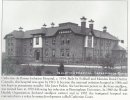I had the greatest displeasure to be an onlooker and bit part player to one of our darkest deeds from the not-so-good closet of Brum history. Namely, the day we gave smallpox back to the world…for an instant anyway, and it could have been so much worse...
Geneva, Switzerland, May 8, 1980 - The 33rd World Health Assembly declares solemnly that the world and all its peoples have won freedom from smallpox - perhaps the most virulent of all pestilential diseases since the earliest of times
The planned campaign to achieve eradication began in January 1967 on an experimental scale. That year, 43 countries experienced more than 10 million cases and 2 million deaths. All countries feared the disease and continued long-standing smallpox vaccination programs whether or not they had cases. International travellers were required to carry certificates showing that they had been recently vaccinated. The goal was to reach 80 percent vaccination coverage for all children throughout the world by 1990. Gradually and incredibly, given the scale, logistics, and costs of the programme, the disease died out, and there hadn't been a confirmed case since 1976.
But the best laid plans o’mice and men… In August 1978, 40 year old Janet Parker was the last person to die from smallpox. She was a medical photographer and worked in the Anatomy Department of the University of Birmingham Medical School, just across the road from the Maternity Hospital where I was working. Janet died after being accidentally exposed to a strain of smallpox virus that was grown in a research laboratory, on the floor below the Anatomy Department. My link was via my best mate, the late Dr Gordon Skinner, a gynaecologist from Glasgow, who had quit clinical medicine in our Department as he didn’t like operating much, and had joined the Medical Microbiology and Virology Department as a Senior Lecturer a few years before, to work on a vaccine for Herpes Simplex type 2, the genital strain. For my sins, I did all the cytology on the experimental mice with him and other colleagues, as we studied the cellular effects pre and post this novel vaccination. In the mid 70’s Herpes Type 2 was the scourge of Gynaecology, being implicated not only as a very unpleasant and recurrent painful disease, but also as a potential cause of cervical cancer and infant mortality.
An official government inquiry into Parker's death was led by Professor R. A. Shooter, whose report was debated in the British Parliament. Parker's death triggered radical changes in how dangerous pathogens were studied in the UK. The University was prosecuted by the Health and Safety Executive for breach of Health and Safety legislation but was cleared in Court.
Smallpox is an infectious disease unique to humans, caused by either of two virus variants named Variola major and Variola minor. The disease is also known by the Latin names Variola or Variola vera, which is a derivative of the Latinvarius, meaning spotted, or varus, meaning "pimple". The term "smallpox" was first used in Europe in the 15th century to distinguish variola from the great pox (syphilis).
At the time of her death, Parker lived in Burford Park Road, Kings Norton, Birmingham, UK, and was employed at the University of Birmingham Medical School. She often worked in a darkroom above a laboratory where research on live smallpox viruses was being conducted. The viruses probably spread through a service duct that connected the two floors. On August 11, 1978, Parker (who had been vaccinated against smallpox in 1966) fell ill; she had a headache and pains in her muscles. She developed spots that were thought to be a benign rash. Ms Parker was admitted to East Birmingham (now Heartlands) Hospital on August 24 and diagnosed as being infected with Variola major, the most lethal strain of smallpox. The next day, smallpox virus was confirmed by electron microscopy on fluid from her rash. Janet Parker was transferred to Catherine-de-Barnes, (then an isolation hospital) where she died of smallpox on September 11, 1978. Many people had close contact with Parker before she was admitted, but only her mother contracted the disease. Parker's mother, Hilda Witcomb, survived, but her father, Frederick Witcomb, died aged 77 following a cardiac arrest when visiting Parker in the hospital.
On September 6, Professor Henry Bedson, the son of Sir Samuel Phillips and the head of the medical microbiology department, committed suicide. He cut his throat in the garden shed at his home and died at the Queen Elizabeth II Hospital in Birmingham a few days later. His suicide note read "I am sorry to have misplaced the trust which so many of my friends and colleagues have placed in me and my work." As far as I knew him, he was a kindly, quiet and reserved academic who just got on with stuff..
In 1977, the World Health Organisation (WHO) had told Henry Bedson that his application for his laboratory to become a Smallpox Collaborating Centre had been rejected. This was partly because of safety concerns; the WHO wanted as few laboratories as possible handling the virus. The declassified official report on the incident noted that Bedson failed to inform the authorities of changes in his research that could have affected safety. Shooter discovered that the Dangerous Pathogens Advisory Group inspected the laboratory on two occasions and each time recommended that the smallpox research be continued there, despite the fact that the facilities at the laboratory fell far short of those required by law. Several of the staff at the laboratory had received no special training. Ahem. Bedson even allowed a school-leaver to work with smallpox after only nine months as a trainee technician. Inspectors from the World Health Organisation had told Bedson that the physical facilities at the laboratory did not meet WHO standards, but had nonetheless only recommended a few changes in laboratory procedure. Bedson lied to the WHO about the volume of work handled by the laboratory, telling them that it had progressively declined since 1973, when in fact it had risen dramatically as Bedson desperately tried to finish his work before the laboratory closed. Janet Parker had not been vaccinated recently enough to protect her against smallpox.
The report concluded that Mrs Parker had probably been infected by a strain of smallpox called Abid (named after one of its earlier victims, a three-year-old Pakistani boy), which was being handled in the smallpox laboratory during July 24–25, 1978. The virus had travelled in air currents up a service duct from the laboratory below, to a room in the Anatomy Department which was used for telephone calls; on July 25, Parker had spent much more time there than usual ordering photographic materials because the financial year was about to end.
As an aside, the Parker case provides a major plot element in the Patricia Cornwell novel Unnatural Exposure. The killer, an apparently respectable microbiologist, turns out to have been a junior researcher at the medical school at the time of Parker's death, and to have been scapegoated for the accident after Professor Bedson's suicide. Nursing a grudge over her blighted career, she develops a new strain of poxvirus from material stolen from the Birmingham lab, and attempts to start an epidemic. The case has also been briefly mentioned in the TV series House in episode A Pox on Our House. Janet Parker was mentioned by name in the episode, while Henry's subsequent suicide was referenced.
Having spent many hours working in the Labs next door to the actual virus storage source before, during, and after this event, I must confess my underwear bills were increased exponentially as the story unfolded, but at least me and many others lived to tell the tale…



 birminghamhistory.co.uk
birminghamhistory.co.uk
birminghamhistory.co.uk






